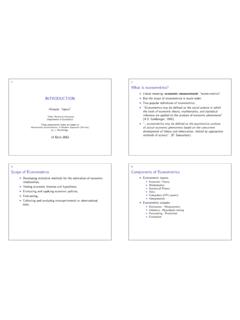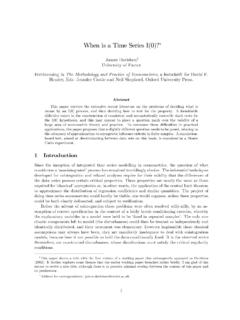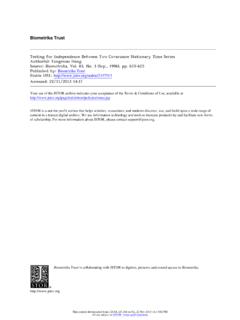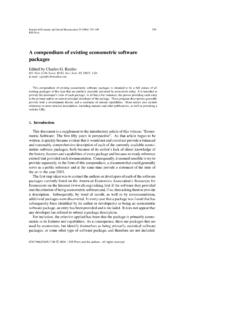Transcription of The Forecasting Dictionary
1 Principles of Forecasting : A Handbook for Researchers and Practitioners, J. Scott Armstrong (ed.): Norwell, MA: Kluwer Academic Publishers, 2001. The Forecasting Dictionary Updated: October 23, 2000 J. Scott Armstrong The Wharton School, University of Pennsylvania, Philadelphia PA 19104 "But glory doesn't mean "a nice knock-down argument," Alice objected. "When I use a word," Humpty Dumpty said, in a rather scornful tone, "it means just what I choose it to mean neither more nor less." "The question is," said Alice, "whether you can make words mean so many different things.
2 " "The question is," said Humpty Dumpty, "which is to be master that's all." Through the Looking Glass Lewis Carroll This Dictionary defines terms as they are commonly used in Forecasting . The aims, not always met, are to: ??provide an accurate and understandable definition of each term, ??describe the history of the term, ??demonstrate how the term is used in Forecasting , ??point out how the term is sometimes misused, and ??provide research findings on the value of the term in Forecasting . Acknowledgments Geoff Allen and Robert Fildes inspired me to develop a comprehensive Forecasting Dictionary , and they provided much advice along the way.
3 The Oxford English Dictionary was helpful in developing this Dictionary , partly for definitions but, more important, for ideas as to what a Dictionary can be. Most of the authors of Principles of Forecasting provided definitions. Definitions were also borrowed from the glossaries in Armstrong (1985) and Makridakis, Wheelwright and Hyndman (1998). Stephen A. DeLurgio added terms and revised definitions throughout. Eric Bradlow reviewed all statistical terms, and Fred Collopy reviewed the complete Dictionary . Sandy D. Balkin, Robert G. Brown, Christopher Chatfield, Philip A.
4 Klein, and Anne B. Koehler also made good suggestions, and many others provided excellent help. The Forecasting Dictionary was posted in full text on the Forecasting Principles website in October 1999 and e-mail lists were notified in an effort to obtain further peer review; many suggestions were received as a result. Mary Haight, Ling Qiu, and Mariam Rafi provided editorial assistance. PRINCIPLES OF Forecasting 2 Abbreviations and Acronyms Following are commonly used symbols. I give preference to Latin letters rather than Greek. Symbol Description Symbol Description A Actual value of a forecasted event MdRAE Median Relative Absolute Error ?
5 ,??? alpha, beta, and gamma: smoothing factors in exponential smoothing for average, trend, and seasonality, respectively, they represent the weights placed on the latest value MSE Mean Square Error APE Absolute Percentage Error n sample size (number of observations, that is the number of decision units or number of years in a time series) ARMA AutoRegressive Moving Average OLS Ordinary Least Squares ARIMA AutoRegressive Integrated Moving Average PI Prediction Interval b measure of the impact of variable x on the dependent variable Y in regression analysis p probability e error r correlation coefficient F Forecast value R2 coefficient of determination G Growth or trend (it can be negative) RAE Relative Absolute Error GMRAE Geometric Mean of the Relative Absolute Error RMSE Root Mean Square Error h forecast horizon S Seasonal factor j period of the year t time.
6 Also a measure of statistical significance MAD Mean Absolute Deviation v number of variables MAE Mean Absolute Error w weighting factor MAPE Mean Absolute Percentage Error X explanatory or causal variable MAPE Adjusted Mean Absolute Percentage Error; in which the denominator is the average of the forecasted and actual values. Also called the Symmetric MAPE. Y dependent variable (variable to be forecasted) THE Forecasting Dictionary 3 Terms Underlined terms are defined elsewhere in the Dictionary . Terms are linked to relevant pages in Principles of Forecasting using PoF xxx.
7 Acceleration. A change in the trend, also including a negative change (deceleration). Although there have been attempts to develop quantitative models of acceleration for Forecasting in the social and management sciences, these have not been successful. Of course, if one has good knowledge about its cause and its timing, acceleration can be a critical part of a forecast. Consider this when skydiving and you need to predict when to open a parachute. PoF xxx Accuracy. See forecast accuracy. ACF. See autocorrelation function. Actuarial prediction. A prediction based on empirical relationships among variables.
8 See econometric model. Adaptive Conjoint Analysis (ACA). A method conceived by Rich Johnson (of Sawtooth Software, Inc.) in which self-explicated data are combined with paired-comparison preferences to estimate respondents utility functions. ACA is a computer-interactive method in which the self-explicated data collected from a respondent influence the characteristics of the paired objects shown to the respondent. PoFxxx Adaptive parameters. A procedure that reestimates the parameters of a model when new observations become available. Adaptive response rate. A rule that instructs the Forecasting model (such as exponential smoothing) to adapt more quickly when it senses that a change in pattern has occurred.
9 In many time-series Forecasting methods, a trade-off can be made between smoothing randomness and reacting quickly to changes in the pattern. Judging from 12 empirical studies (Armstrong 1985, p. 171), this strategy has not been shown to contribute much to accuracy, perhaps because it does not use domain knowledge. PoFxxx Adaptive smoothing. A form of exponential smoothing in which the smoothing constants are automatically adjusted as a function of forecast errors. (See adaptive response rate.) PoFxxx Additive model. A model in which terms are added. See also multiplicative model.
10 Adjusted Mean Absolute Percentage Error (MAPE). The absolute error is divided by the average of the forecast and actual values. This has also been referred to as the Unbiased Absolute Percentage Error (UAPE) and as the symmetric MAPE (sMAPE). Adjusted (See also R2.) R2 adjusted for loss in the degrees of freedom. R2 is penalized by adjusting for the number of parameters in the model compared to the number of observations. At least three methods have been proposed for calculating adjusted R2: Wherry s formula [1-(1-R2) (n-1)/(n-v)], McNemar s formula [1-(1-R2) (n-1)/(n-v-1)], and Lord s formula [1-(1-R2)(n+v-1)/(n-v-1)].









